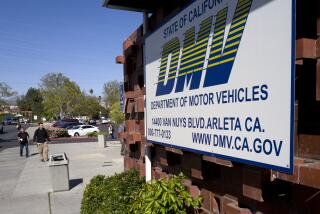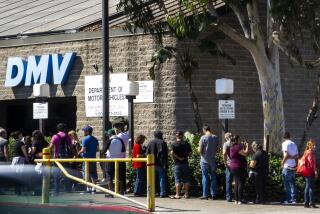HIGH LIFE : DRIVING AMBITION : Teachers in the Hot Seat Tell Why Training Teens Can Be Heck on Wheels
- Share via
Screeching brakes, corners taken at 30 m.p.h., ashen-faced teen-agers cowering in the back seat--these are the signs that a student driver is behind the wheel.
High school students must go through a driver education class to earn the green permission slip that allows them to get a driver license at age 16. For many, the first time behind the wheel can be traumatic, scary or just plain embarrassing.
The school parking lot is where it all begins, but some students are not as eager to drive as many expected they would be. Jay Harron, coordinator of driver education at Laguna Hills High School, recalls the time when three students who were to drive that day piled into the back seat, waiting for someone else to take the wheel.
“Driving out of the school parking lot might be the most embarrassing moment of your high school career,” said Mike McKenzie, coordinator of driver education at El Toro High School. “Just being in the car in general is embarrassing, because the kids know that when they were in the seventh, eighth, and ninth grades, they used to harass the ‘driver ed’ cars. Everybody who sees you laughs. You’re really a marked person in one of those cars.”
Driving out of the parking lot can be even more frightening when other drivers try to scare the student drivers.
“Every day,” McKenzie recalled, “this guy in all black would race around and around the back parking lot on his motorcycle. One day, when we made a left out of El Toro High School, I saw this motorcycle heading toward the embankment leading out of the parking lot. The next thing I knew, he came up the embankment, full speed, hit the top and actually flew through the air, through the trees and landed right in front of our car.”
Some student drivers panic when it is their turn behind the wheel. McKenzie said it is not unusual for students to race toward the only light pole in the parking lot. Fortunately for the instructors, all driver education cars are equipped with brakes on the instructor’s side.
But sometimes brakes are not enough. Bob Janko is a Capistrano Valley High School mathematics teacher and owner of the Foster-Janko Driving School, which has contracts with the Capistrano and Tustin unified school districts. He remembered one especially close call when he wished he’d had an accelerator instead of the brake.
A girl student driver had stopped the car in the middle of the intersection, waiting to make a left turn, Janko said. He could not see the oncoming cars, so he told her to go when it was safe. The girl unabashedly turned right into the path of a group of oncoming cars. Realizing that she should have waited, she slammed on the brakes and screeched to a halt.
“Sometimes,” Janko said, “all I have time to do is say a few, quick prayers.”
Another student driver was approaching a yellow light. He also panicked and hit the brakes, sending the car spinning in the intersection.
“Even good drivers can panic and do something unexpectedly,” McKenzie said.
Even the students who seem most likely to be cool under pressure sometimes aren’t. McKenzie recalled, with a laugh, the football player who started hyperventilating during his driver test. Back at the school, the player said, “Whew, that was really scary.”
McKenzie said he can often tell when students are going to be bad drivers even before he gets into the car with them.
“The most memorable student I had was a young man who had very thick glasses,” McKenzie said. “He looked like the type that just wasn’t a driver. We were driving around, and he kept bashing into curbs, going over curbs and you name it. Every time he would make a mistake I’d say, ‘John, you just hit a curb,’ and he would look at me and go, ‘Hee, hee, hee.’ This just kept going on and on. We finally did get back to the school, and I said, ‘Well, John, you didn’t pass.’ He just looked at me and goes, ‘Hee, hee, hee,’ and walked away.”
Jay Harron of Laguna Hills High School remembered one of his students who reacted a bit differently to her mistakes: “We came off the freeway one time in the rain, and the student driving hit the gas pedal instead of the brake We went into four-wheel gridlock. No one was hurt--all the car did was just go into a 360 a couple of times and then come to a stop.
“Then the girl asked, ‘Did I fail freeway?’ ”
Harron added: “The most common thing is for people to drive up on curbs. Then they’ll look right at you and say, ‘We’re on the curb.’ ”
Going over the curb, especially during the part of the test when students must back up to the curb, is probably the most common mistake of the student driver, McKenzie said.
“There’s one curb over here that’s black from where we scrape it with our tires,” he said.
Student drivers also make many mistakes when changing lanes, McKenzie said. Some student drivers will inadvertently use the column shifter instead of the turn-signal lever and put their cars in reverse. A student driver looking over his shoulder to change lanes often forgets about steering his car.
Of course, things can be more frightening when the student forgets to look over his shoulder. Joe Reed, in one of his earlier days as driver education coordinator at Mission Viejo High School, told a student to change to the left lane. Before he could add “after you’ve checked your mirror and looked over your shoulder,” the student had moved to the left.
Unfortunately, a Volkswagen was already racing along in that lane. To avoid a collision, the Volkswagen driver yanked his car onto the island in the middle of the road.
Ever since, Reed has started his driving instructions with “When it’s clear. . . .”
In another incident, Reed recalled a girl who was trying to avoid a tractor-trailer rig while changing lanes. She panicked, and the car swerved, skidded off the side of the road, rolled down an embankment and plowed into construction equipment.
Although some student drivers may seem totally unfit and unprepared to hit the road, all the driver education teachers said they never take students who do not appear ready. All students are advised to practice with their parents before taking the driving test for the permit.
McKenzie remembered one time when he passed out permits on a Friday and told the students to go practice on a particularly quiet street with their parents over the weekend. “The next morning I was out with another driver education group, and I saw 150 new drivers on this street with their parents. They were going all over the place. It was a riot.
“I really think students would do almost anything to get that green slip. If you told them to jump out on the freeway at 80, they would probably do it if it meant getting the license. A lot of kids are into school, and some aren’t, but one thing all kids have in common is they want that driver’s license.”
More to Read
Sign up for Essential California
The most important California stories and recommendations in your inbox every morning.
You may occasionally receive promotional content from the Los Angeles Times.










